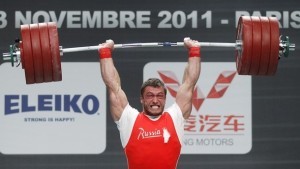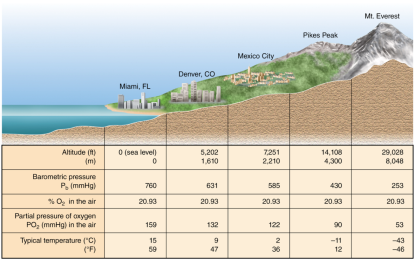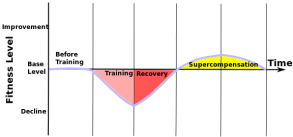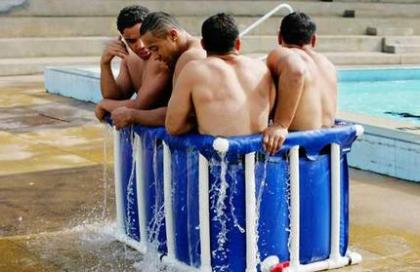What is Olympic lifting?
Olympic lifting is the aim to lift the most amount of weight in the two competition lifts of the Snatch and Clean & Jerk. However, what makes the movements difficult is the technique used which requires a high amount of explosiveness and strength to be successful. The sport of Olympic weightlifting has been in many forms but the modern version has been around since 1972.
How does it affect performance?
Due to short explosive nature of the Olympic lifts and their variations it is evident that the anaerobic ATP-PC energy system is key to effect performance and use of these movements. The use of Olympic lifts develops the neuromuscular patter in multiple joint partners known as triple extension ie: the hip, knee and ankle when jumping or sprinting. The triple extension process begins with the closing of the joints, followed by a fast opening of the joints. By developing this neuromuscular pattern it allows for faster recruitment of muscle and so increasing the speed of the contractile force.
Using Olympic lifts to develop power
Over the years different training methods have been used to develop power (Hoffman, 2004) due to its vital importance in all sports. The difference in the best athletes/players in the world is their ability to generate power whether this is to beat an opponent or to force an opponent to the ground from a tackle. To help develop this differentiating feature in sport Research (Johnson, et al, 2008) suggest that with the use of the Olympic lifts in training, Power output, increased force development and efficient neuromuscular patterns can all be developed.
Even though power consists of force x velocity, the contribution to the physical demands of power in training is not so equal. There have been two trains of thought when considering the development of power. The development of strength and then subsequent practice in the sporting activity or the development of explosive power, which seems the most effective due to explosive power being a learned skill from the neuromuscular system (Gamble, 2010, pg 79)
Traditional methods such as Power lifting can produce strength however, this method of developing strength, can be characterized as being of slow speed and have a negative effect on the explosive power of athletes (Johnson Sabatini, Sparkman, 2008). To account for this need to develop speed-strength as opposed to speed-strength, which is defined by Athlepedia to be “the ability of the neuromuscular system to produce the greatest amount of force in the shortest possible time and is characterised in 3 components. Starting strength, Explosive strength and reactive strength”.
Hoffman’s 2004 study, conducted a study with 20 College Level American footballers to show the differences between powerlifting and Olympic lifting in the development of power. What was found was both groups developed significant gains in their strength, measured through a 1RM Back Squat however, those who had used Olympic lifting in their training developed a greater improvement in their Vertical Jump (VJ) This was supported further by Channel and Barfield (2008) who showed that both methods increased VJ however Olympic lifting was produced greater gains.
However, Hakkinen et al (1987) found that after observing a years training with elite weightlifters that the development of the Stretch shortening cycle had improved but it had become slower in its application of force. Hakkiken et al put this down to the concretion dominance involved in the Olympic lifts. There is also uncertainty surrounding the bi-lateral nature of the lifts that their application to uni-lateral events such as sprinting are debatable (Youngs, 2006). Therefor it may be more beneficial to consider the split variations of the Olympic lifts.
Technical Breakdown and my own use of Olympic lifts
In the following section I will demonstrate the Olympic lifts in their different variations for each lift. So for the Snatch, I will be showing the Full Snatch, Power Snatch and hang power snatch. For the Clean & jerk I will be demonstrating, the full clean and jerk, power clean, hang clean and the full split clean.
For each exercise I will attempt to highlight the technical demands of each lift, with links to people more experienced than me in the field to better explain the process. As a minor detail for those wanting to know more about how to perform the lifts, “the hook grip” is used as to prevent a weak grip effecting how much a person can lift.
Snatch
For an example of a powerful snatch see the video below of Russian Weightlifter Dimity Klokov lifting 205kg.
Full Snatch
The bar starts over the middle of the foot, not too close to the body, with shoulders slightly in front of the bar. There should be space a significant space between the hip, arm and chest to know if this is correctly set up. As the first pull begins, the back angle of the athlete should remain the same as the original set up angle, with the bar being pushed up by the legs rather than pulled by the arms and upper body. On the second pull, the bar does not go around the knees; rather the knees are sent back to be in the correct position. Once past the knee, you want the hips to open up and be ready in the power position, however shoulders still need to remain over the bar. Once past knee, the triple extension begins, with a violent extension of hips, knees and ankles and done efficiently should result in the bar being overhead. During this phase of the lift the bar will become ‘weightless’. At this point the athlete should drop underneath the bar and be in the catch position, with arms turned out and core tight to maintain strength throughout the movement. The athlete can then stand with the bar still overhead to complete the lift.
Power Snatch
The power snatch is the same as the full snatch, however during the catch phase the athlete must not go below 90 degrees knee angle. This variation can allow for more focus on the power development of the lower joints.
Hang Snatch
The hang snatch allows for those with weak technique o begin to understand the triple extension required to efficiently lift the bar. The bar is brought up to the ‘hip pocket’; the gap between the pubic bone and waist and from this position the athlete violently extends hips, knees and ankles to move the bar from the hip to the catch position overhead at either the power or full depth position.
Clean
For an example of an elite clean and jerk, look no further than Pyrro Dimas
Full clean and Jerk
The starting position of the clean involves the bar over the middle of the foot, a nice flat back, with hips way below the shoulders with those shoulders over the bar. The grip width should be just outside of the knees as to allow the athlete to lift without connecting with those knees. To begin the first pull, the back remains at the same angle as set up with bar being pushed up to mid thigh level from the legs, with knees being sent back and out rather than going around the knee. From the mid thigh position, the athlete then enters the transition or 2nd pull, the athlete extends the hip create a vertical back, with shoulders back and to shove the knees under the bar with knees still bent. This allows for a strong power position for the final part of the clean portion. From this position the athlete will engage the triple extension and include a shrug and drop underneath the weight at the moment of weightlessness. If done effectively then the athlete will jump from the ground and the bar will land on the shoulders. When catching the bar in the front rack position it is important to catch in only a few fingers grip as due to flexibility it is difficult to do so.
Jerk
In the Jerk part of the lift, the hook grip is released to a normal grip. The athlete dips and drives up to full extension with bar overhead, over the middle position of the body. The legs split front and back with the back leg acting as support and the front providing the drive the complete the lift overhead in full extension with straight legs.
Power Clean
This follows the same pattern as the full clean however the bar is caught above 90 degrees knee angle in the front rack position.
Hang clean
The hang clean variation involves starting from the ground and bringing to the hip or starting from blocks to high hang position. The athlete then finds their position and drives through their triple extension of the hip, knee and ankle to finish in the from track position.
Summary
Olympic weightlifting can be beneficial for training power in athletes, if the sport of participation reflections the specific adaptations which will because. However, the lifts can be manipulated to suit uni-lateral events in such exercises as the split snatch or the split clean and jerk. The teaching of technique to the athletes allows for the better development of the triple extension patterns in the athletes when performing in their sport of choice. So it is down to the coach or player to ensure that the exercises are safe and do not increase the risk of injury.
Reference:
- Channell, B.T & Barfield, J.P. (2008). Effect of Olympic and traditional resistance training on vertical jump improvement in high school boys.Journal of strength and conditioning research. 22 (1), 1522-1527
- Gamble, P (2010). Strength and conditioning for team sports: Sport Specific physical preparation for high performance. London, UK: Routledge. 79
- Hakkinen, K & Komi, PV & Alen, M & Kauhanen, H. (1987). EMG, Muscle Fibre and force production characteristics during a one year training period in elite weightlifters. Europen Journal of Applied Physiology. 56, 419-427
- Hoffman, J & Cooper, J & Wendell, M & Kang, J. (2004). COMPARISON OF OLYMPIC VS. TRADITIONAL POWER LIFTING TRAINING PROGRAMS IN FOOTBALL PLAYERS. Journal of strength and Conditioning Research. 18 (1), 129-135
- Johnson, J.B, Sabatini, P.L & Sparkman, M.R. (2008). A debate between power lifting and Olympic lifting as the main athletic training method.Virginia Journal. 29 (4), 19-23.
- Young, B. (2006). Transfer of strength and power training to sports performance. International Journal of Sports Physiology and Performance. 1, 74-83





 The effects of altitude become a factor around 1,000 to 2,000 meters above sealevel (Wilmore, Costill & Kenney, 2008) with less than 500m being considered sea level. Moderate altitude levels range from 2,000 to 3000 meters and it is at this level that performance is significantly affected, with the higher ranges of altitude 3,000m plus showing severe effects health as well as on performance. Due to the air reducing pressure and being thinner at these higher altitudes, it can actually disrupt the sensory control of athletes and influence their balance and co-ordination. This decreased air resistance can play an advantage in sporting contexts such as ball-orientated sports such as football or American Football. Could this be why Peyton Manning, the QB of the Denver Broncos, who plays at 1732 meters above sea level broke the passing yards record in the NFL this season?
The effects of altitude become a factor around 1,000 to 2,000 meters above sealevel (Wilmore, Costill & Kenney, 2008) with less than 500m being considered sea level. Moderate altitude levels range from 2,000 to 3000 meters and it is at this level that performance is significantly affected, with the higher ranges of altitude 3,000m plus showing severe effects health as well as on performance. Due to the air reducing pressure and being thinner at these higher altitudes, it can actually disrupt the sensory control of athletes and influence their balance and co-ordination. This decreased air resistance can play an advantage in sporting contexts such as ball-orientated sports such as football or American Football. Could this be why Peyton Manning, the QB of the Denver Broncos, who plays at 1732 meters above sea level broke the passing yards record in the NFL this season?






